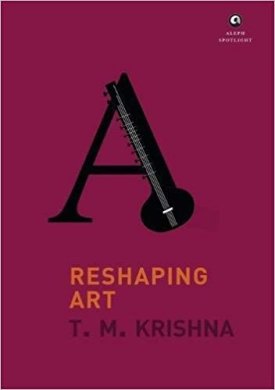
|   |

|   |
 Art begets what art gets! Art begets what art gets!- Kasturika Mishra e-mail: kasturika69@gmail.com January 3, 2019 I started encountering the artiste T.M. Krishna from a tweet by my arts world friends and found a man similar in taste. He was barred from entering Delhi to perform in a cultural festival managed by the government due to his unconventional thoughts. That led to a melting point when I held Krishna's book in hand to read. 'Reshaping art' is a series of deep thoughtful essays on practices in art forms and the psychology of the artist in classical and folk traditions of India. Quoting his words, "The greatest obstacle in freeing the arts from their burdens is convincing insiders that they are indeed unwelcoming. Whenever I raised this issue with the torchbearers of high art, the immediate response is: we have never said, 'Don't come!'" This is the doggedness with which our high priests of cultural world operate and deliver. They have fixed the auditorium/concert audience as an elitist class of patrons, intellectuals, "reserved seats" listeners who connect with the artiste as devoted disciples and audience. If an artiste like Krishna starts performing on a beach festival and some of the village folks, flea market sellers come over to listen and enjoy the soothing fare, it's a transgression that is not tolerated. Krishna has taken references from ancient textual songs like kritis of Carnatic music which are supposed to be uttered and sung in particular musical settings, attires, and ambience and by a typical caste of musicians. Any trespassing or devolution is not allowed in such a rigid regime. He quotes experiences from the festival, "where everyone began dancing. Rich, poor, children, older women, fisher-folk, businessmen, artistes and students dance in abandon... the upper caste and fisher-folk shared music, dance, tea and bajjies." That the festival was smelting pot for homogenizing the rudimentary concert culture was evident and should be introduced by the latest generations is what Krishna wants to tell the readers. The transcendent quality of music of any form whether vocal or instrumental music and their deliberations is beyond any feeling of religious dogma and prosaic grammar. The process of exchange between the doer and the receiver is intimate and not limited to monetary worth of the organizer and is not a ticketed affair. The amalgamation of folk culture where a dancer is relating to the listener is same as any organized opera in a closed high end concert stage. Krishna also draws connection with instances from Tamil cinema and universality of art amongst commoners. The ethos are the same everywhere that naturalizes the experiences to an ardent follower of art, be it classical music, cinema or folk performances. The beautiful description of Devadasis and their relegation to a life of penury from the iconic status they enjoyed in Hindu temple pantheon is also a vital point in 20th century that Krishna explains as the transformation within the dance culture. The Isai Vellalar community who danced Sadir (erstwhile Bharatanatyam) were stigmatized as prostitutes the moment Devadasi system was abolished. Suddenly, the Brahmin high class abhorred these ladies and their male heirs became upholders of dance traditions and a patronization of elite business class made this alliance a deadly concoction of making art a business proposition. The local music and dance practitioner travelled from his grassroots to the level of closed havelis and palaces where common people had no entry. Ritualistic practices seeped in, like putting bindi, doing kolam, maintaining sexual chastity for musical clans, took away the aesthetics that the arts held so prime to its existence. Primarily it became a fašade of showcasing beauty of arts sans the flavor of the land. In another passage, T.M. Krishna entails, "Theyyam is a Hindu ritual performance art practiced by the lower castes of Kerala. Performed in North Kerala by men of certain lower castes such as Vannan, Malayan, Velan, Mavilan, and Pulayan, Theyyam is performed at independent shrines attached to ancestral homes, often belonging to the upper castes." This dichotomy of caste difference is what T.M. Krishna talks about when he says art has brought in divisive factors into the purity and sanctity of performance. Even within the same styles, Theyyam and Kathakali are not at par. While the practitioners are of same mindset, their social strata isn't conducive to gaining acceptability as equals. This deflecting trend is what T.M. Krishna is trying to address and as Indians we should stand feet to feet, hand to hand with the artiste on this thought. A worthy read for all art connoisseurs. Kasturika Mishra is a Cataloging Library Specialist, music and dance critic, blogger at Mihika Mishra on facebook. Post your comment Unless you wish to remain anonymous, please provide your name and email id when you use the Anonymous profile in the blog to post a comment. All appropriate comments posted in the blog will also be featured in the site. |